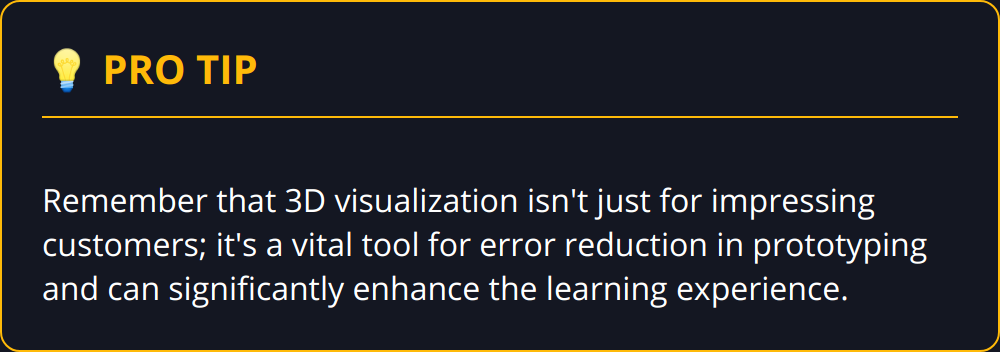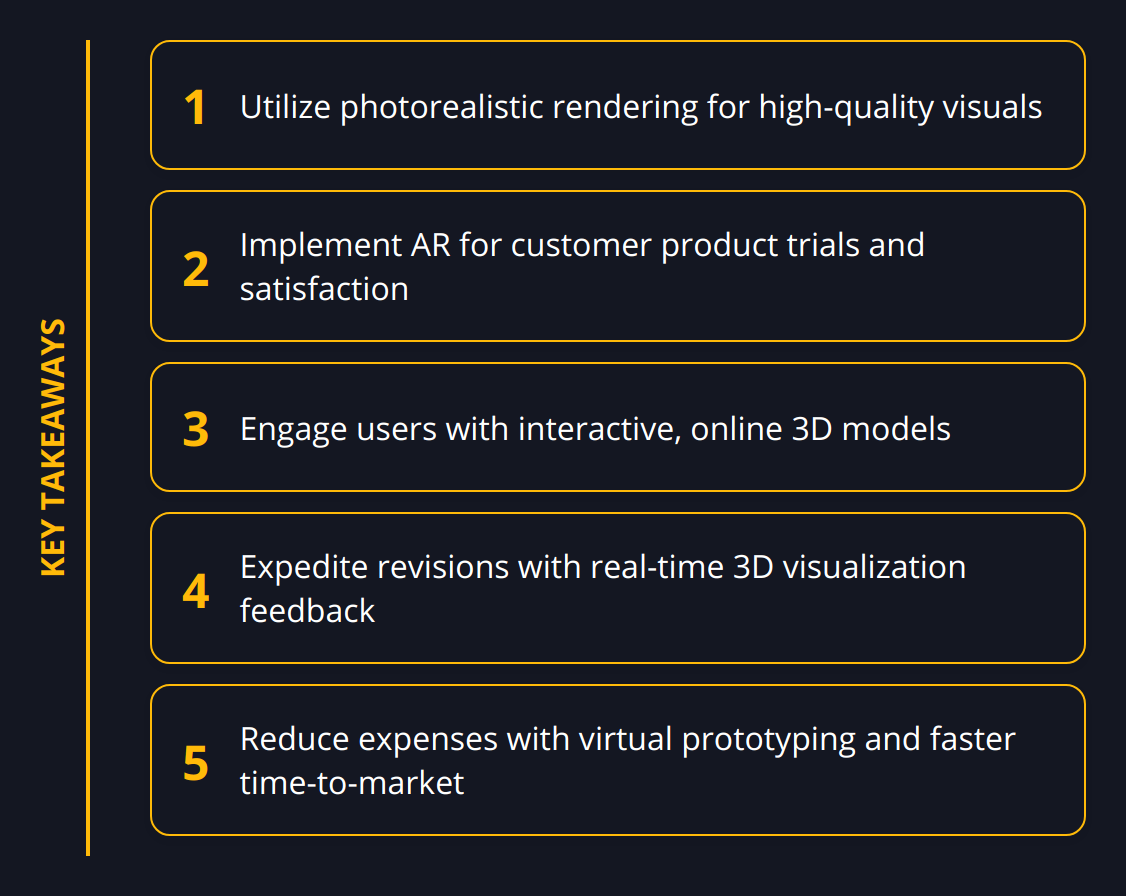We at Newroom Connect believe visual impact is an unwavering asset in today’s business landscape. 3D visualization stands at the forefront, transforming the way companies showcase products, train staff, and engage with customers.
Understanding its techniques and tools is more than a passing trend—it’s a strategic move with tangible benefits for businesses across various industries. Let’s explore the world of 3D visualization to see how it could elevate your business operations and customer experiences.
Harnessing 3D Visualization
3D visualization is essentially the art of using software to create three-dimensional graphics. It allows businesses to convert flat, uninspiring concepts into dynamic, engaging views that can capture the essence of a product or space with realistic detail and depth.
The Essentials of 3D Visualization
Visualizing in three dimensions is about creating a digital scene that resembles real-world objects or concepts. Imagine being able to showcase a product prototype in full detail from every angle, long before it physically exists. It goes beyond simple imagery, offering an interactive experience that can help clients and customers understand the true value and features of your offerings.
The process typically begins with 3D modeling, the cornerstone of any 3D visualization project. This technique involves constructing the foundation of your 3D scene – the raw digital sculptures that shape everything from a basic chair to complex machinery. If 3D modeling is the skeleton, then texturing, lighting, and rendering are the flesh, skin, and clothing that bring it to pulsating life.
Popular 3D Visualization Methods
Businesses mainly employ a range of 3D visualization techniques as per their needs:
-
Photorealistic Rendering: Could your marketing benefit from visuals that mimic reality down to the reflection on a glass surface or the texture of fabric? Photorealistic rendering is the answer, as it creates images that could easily be mistaken for photographs.
-
Augmented Reality (AR): By superimposing your product or design into the real world through a smartphone or AR glasses, customers can test products in their environment before making a decision, thus reducing returns and boosting satisfaction.
-
Virtual Reality (VR): For an immersive experience, VR can teleport users into a new environment. It’s a game-changer for industries such as real estate that rely on spatial understanding, allowing clients to tour buildings that are yet to be constructed.
-
Interactive 3D Models: Interactive models are crucial for customer engagement. Through simple online tools, clients can rotate, zoom, and dissect products, fostering a sense of ownership and curiosity.
Tools That Bring Ideas to Life
Selecting the right tool for your 3D visualization needs is a pressing concern. Powerful software like Blender or SketchUp can transform conceptual sketches into lifelike creations, while Unity is a great choice for interactive experiences. Your decision should be informed by factors such as ease of use, compatibility with your existing systems, and the level of detail required for your projects.
The Business Benefits of 3D Visualization
This technology isn’t just flashy—it’s a magnet for customer attention and a catalyst for clearer communication. Here’s a brief snapshot of the advantages:
-
Increased engagement: Users spend more time interacting with 3D visuals, leading to higher conversion rates.
-
Cost savings: 3D models reduce the need for physical prototypes, which can be expensive and time-consuming to produce.
-
Better training: For complex machinery or processes, a 3D model can serve as an excellent training tool, circumventing the risks and costs associated with real-life training.
-
Enhanced problem-solving: Identifying design flaws becomes easier when you can explore a product from every conceivable angle before it goes into production.
3D visualization is not a mystical art; it’s a strategic necessity. If your business hasn’t adopted these techniques, you’re not just behind—you’re missing out on a wealth of opportunities. For a practical guide on integrating AR to your business, you might find our interactive 3D showrooms resource informative.
Remember, visualization is just the beginning. It’s what you do with these sophisticated images and models that will ultimately define the success of your 3D visualization strategy.
Elevating Marketing Through 3D
Marketers are always on the lookout for innovative strategies to make a product stand out. With the technology available, dynamic visuals are not just an option; they are expected by audiences. Through 3D visualization, marketers can capture the attention of potential customers with life-like product demonstrations and metaphoric peeks behind the curtain of the engineering process.
Transforming Product Demonstrations
3D product visualization is a game-changer for marketing. Imagine showcasing a product with an interactive 3D model that users can explore at their own pace. Statistics show that 3D visualization can increase conversion rates by providing potential customers with a detailed understanding of what they’re buying. For reference, 3D product visualization best practices can guide you on streamlining this process effectively.
Streamlining Design and Prototyping
In design and manufacturing, 3D visualization tools fast-track the prototyping phase by allowing designers and stakeholders to pinpoint flaws and make necessary adjustments early in the development process. By employing 3D visualization, companies have reported a reduction in time-to-market for new products. This not just speeds up iterative design but also results in significant cost savings.
Educational Advancements and Training Simplicity
3D visualization is transforming educational experiences. Instead of reading from a textbook, students and employees can immerse themselves in complex subjects through virtual environments. An example is the adoption of virtual reality workshops for corporate training, which allows for a hands-on approach to learning that improves retention and gives a realistic sense of on-the-job tasks.
Quick Tips for Incorporating 3D Visualization:
-
Use interactive models in online product pages to keep users engaged.
-
Introduce AR-powered apps that allow customers to visualize products in their own space before purchasing.
-
Opt for 360° product views to provide a comprehensive look at your product from all angles.
-
Implement virtual prototypes early in the design process to facilitate feedback and iteration.
-
Invest in VR training modules for a safer and more cost-effective alternative to traditional training methods.

With the rapid advancement of technology, incorporating these 3D visualization techniques is not an option—it’s a strategic imperative for staying competitive and relevant. Adopting such technologies ensures you’re meeting your customers’ evolving expectations with certainty and creativity. The next chapter will build on this foundation, exploring even deeper into the innovation that 3D visualization brings to the table.
Driving Business Growth with 3D Visualization
3D visualization is revolutionizing the way businesses approach marketing, design, and customer service. It’s not just about staying current with the latest tech trends; it’s about leveraging the power of three dimensions to foster a deeper customer connection and streamline operations. Here are practical ways 3D visualization delivers tangible business benefits.
Engage and Illuminate
Today’s market is crowded, to say the least, and standing out is essential. 3D visualization is the boost businesses need to captivate their audience. It invites customers to explore products as if they were physically present, fostering an immersive experience that two-dimensional images can’t match. When users interact with 3D models, they engage on a deeper level, which often translates into increased sales. For example, retailers using 3D views have reported a spike in customer attention, with users spending up to 50% more time on pages that feature 3D models.
Moreover, the enhanced customer understanding that comes from interactive 3D models leads to more informed purchasing decisions, reflected in a decrease in product returns. Our guide on 3D showroom integration can provide insights into creating these compelling online spaces.
Accelerate Decisions and Modifications

Incorporating 3D visualization technology into the decision-making process is a smart move for any business. Product modifications can take weeks or even months using traditional methods, but with 3D visualization, changes can be applied and reviewed in real time, vastly accelerating the revision cycle. Consequently, stakeholders can make faster decisions, which is critical in industries where time is of the essence.
Consider architectural firms—incorporating client feedback can be a drawn-out process when relying on physical models or 2D plans, but with 3D visualization, architects can promptly alter designs, present alternatives, and expedite approvals. This benefit is underscored when presenting complex data that might otherwise be difficult to interpret—having a tangible model to examine accelerates understanding and decision-making.
Slash Costs and Get to Market Quicker
Cost efficiency and time-to-market are make-or-break factors for product success. Traditional prototyping can be prohibitively expensive, especially for small businesses or startups. With 3D visualization, you skip the physical prototype and jump straight to a virtual model that costs only a fraction of the price. This not only saves money but also slashes the time it takes to develop new products, providing a quicker route to market.
Use our expertise on digital prototyping benefits as a starting point to reduce expenses and time in your product development cycle.
Strategies for Leveraging 3D Visualization:
-
Optimize product pages with 3D customer interactions.
-
Introduce AR experiences for try-before-you-buy confidence.
-
Employ virtual walkthroughs in industries such as real estate for better property showcasing.
-
Use 3D simulations for detailed project planning and evaluation.
By integrating 3D visualization techniques into your business workflow, you’re not just following a trend; you’re adopting a strategic approach to drive growth, improve customer satisfaction, and gain a competitive edge. Whether it’s through heightened engagement, streamlined revisions, or cost-effective prototyping, the positive impact of 3D visualization on the bottom line is undeniable. As we advance into an era where digital and physical worlds collide, these innovative visual experiences are not merely beneficial—they’re essential for the progressive business.
In a world that is quickly gravitating towards more dynamic and immersive content, neglecting 3D visualization could mean missing out on a pivotal method to propel your business forward. As we continue our exploration, let’s delve into the next chapter where we’ll discuss how to seamlessly integrate these visualization strategies into your business framework.
Wrapping Up
3D visualization has erupted as a dynamic force in the business arena, reshaping traditional methods and establishing new standards for engagement, design, and customer interaction. It is the touchstone for modern enterprises seeking to elevate their brand in a digital-centric market. The essence of 3D visualization lies not just in its ability to enchant with visual splendor but also to streamline operations and cultivate better customer relationships.

Reflecting on 3D visualization as a part of business practices reveals a unanimous trend: it’s a power move towards optimizing efficiency and captivating audiences. Businesses have witnessed a palpable shift in customer dynamics, with a surge in informed purchasing decisions and a reduction in return rates, thanks to the clarity and immersion that 3D models provide. Similarly, design and prototyping have embraced an accelerated pace, affording businesses a swift transition from concept to market-ready products.
Considering future advancements, the potential for 3D visualization shines brightly on the horizon. As technology marches forward, we anticipate even more intricate and life-like models, interactive experiences that bridge the virtual and physical realms, and AI-driven tools that simplify the creation and implementation of 3D assets. The excitement around what’s next for 3D visualization speaks volumes about its integral role in the growth and innovation of businesses worldwide.
At Newroom Connect, we stand ready to support this digital metamorphosis. Our software harnesses the full spectrum of 3D visualization capabilities, ensuring that businesses can leap into a future where customer engagement, learning, and product showcasing are boundless. Our platform is a beacon for those eager to ride the wave of progressive change brought by virtual exhibitions, showrooms, and e-learning environments.
To cap off, 3D visualization is no fleeting phenomenon; it’s the blueprint for a future woven with digital threads, empowering businesses to shine in a competitive landscape. It’s a strategic and visionary asset, rich with possibilities for those ready to embrace it.
Discover more about how we can help you make this transition seamlessly at Newroom Connect.
-
Enhances customer engagement
-
Streamlines decision-making
-
Reduces costs
-
Accelerates market readiness
As we close this chapter, we recognize the ripple effects of 3D visualization throughout various sectors, driving progress and prosperity. The synergy between advanced technology and innovative business strategies promises a fascinating journey ahead.




